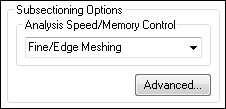 \
\
 \
\
NI AWR MWOffice Interface Subsectioning Options
The Subsectioning Options section of the Sonnet Options property page, shown below, allows you to control the memory usage for a Sonnet EM analysis by controlling the subsectioning of your circuit. The high memory settings produce a more accurate answer and usually increase processing time. Conversely, low memory settings run faster but do not yield as accurate an answer.
![]() For a complete
discussion of subsectioning, Min and Max and edge meshing, please refer
to the ''Subsectioning'' chapter in the Sonnet
User's Guide.
For a complete
discussion of subsectioning, Min and Max and edge meshing, please refer
to the ''Subsectioning'' chapter in the Sonnet
User's Guide.

The Speed/Memory setting is controlled using a slider bar. There are presently three settings, detailed below, for this slider.
Mesh: Fine/Edge Meshing (left): Em uses XMIN and YMIN settings of each individual polygon, and the edge meshing settings of each individual polygon. This is the default setting. It uses the most memory and returns the most accurate answer.
Mesh: Coarse/Edge Meshing (center): Em checks the Xmin value of each individual polygon. If the value is less than 50, em uses 50. Otherwise, em uses the Xmin value of that polygon. Same for YMin. Em uses the edge meshing settings of each individual polygon.
Mesh: Coarse/No Edge Meshing (right): Xmin and Ymin are treated the same as cited for the option above, but em disables edge meshing for all polygons. This setting uses the least amount of memory and runs the fastest but at the cost of some accuracy.
Advanced: Click on this button to open the Sonnet Advanced Subsectioning Options dialog box which allows you to control your subsectioning settings and subsectioning frequency.